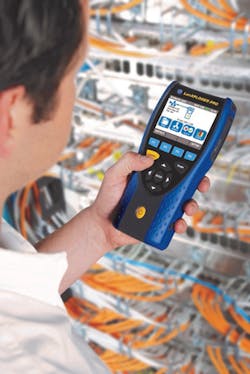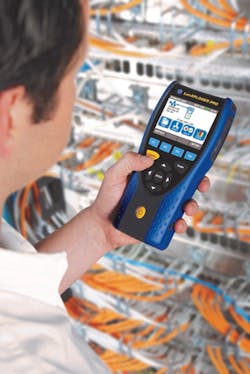By Patrick McLaughlin
In late 2014 the NBase-T Alliance officially unveiled, with founding member companies Aquantia, Cisco, Freescale and Xilinx combining to carry out the group’s stated mission “to promote the development of 2.5- and 5-Gigabit Ethernet technology for enterprise infrastructure.” A little more than a year later the alliance-now boasting approximately four dozen member companies including several manufacturers of cabling technologies-can look back on a successful 2015. In fact, it did just that last month.
On December 9 the NBase-T Alliance released a new MAC-PHY specification and announced the addition of 14 members, which brought its total membership past 45. Peter Jones, the alliance’s chair and a principal engineer with Cisco, commented, “We have spent the last year building consensus with key industry leaders and individuals involved in the IEEE standards process, and providing the industry with specifications in order to begin real product development. We believe our work has accelerated the definition of the 802.3bz standard, and is facilitating the widespread deployment of multigigabit products. We expect 2016 will be a year of widespread product adoption and intend to deliver the supporting specifications and certification programs needed to develop a strong ecosystem around 2.5G and 5GBase-T.”
802.11ac wireless networks are the primary application that prompted the alliance’s formation and technology development. Its efforts aim to enable the transmission of data at 2.5 and/or 5 Gbits/sec over the existing, installed base of Category 5e and Category 6 cabling. “Existing gigabit infrastructure is insufficient to handle 802.11ac deployment,” Jones explained recently on the occasion of the alliance marking its first anniversary. “Gigabit Ethernet has been around since 1999 and has now become the bottleneck. The market needs technology to support greater-than-1-gig over existing cables.”
Such technology, of course, needs to exist in order to be deployed. The first 2.5- and 5-Gbit/sec switch ports began shipping in the second quarter of 2015, the NBase-T Alliance explained, adding that 2.5G and 5G access points are expected in the first quarter of 2016, along with the first network interface cards and test equipment.
Cabling participants
In its first year the alliance gained a number of cabling vendors as members, including CommScope, Fluke Networks, Ideal Networks, Molex and Panduit Corporation, all of whom are contributor-level members. Ideal Networks’ membership is recent; the company announced it joined the alliance on December 11.
At the time of that announcement, Ideal Networks business unit manager Dan Payerle stated, “NBase-T technology extends the life of existing cabling plants by taking a partial step between 1G network speeds and 10G, and therefore creating a low-cost path to multigigabit speeds. Simply by changing to network equipment based on NBase technology, network owners can increase speeds of their existing Category 5e and Category 6 cables up to 5 Gbits/sec at lengths up to 100 meters, saving recabling costs, installation time, and invasive disruption to the physical infrastructure of any enterprise building.”
He also noted that it is critical that end users or network equipment resellers test the existing cabling plant’s ability to support higher speeds before NBase-T equipment is installed. “Because material quality and installation workmanship varies greatly, it is strongly advised that key metrics in the cabling be retested before committing to the equipment upgrades to ensure seamless, robust operation. Ideal Networks and the NBase-T Alliance are collaborating to establish recommended test methods for installed cable infrastructure in enterprises around the world.”
The alliance plans to formalize a certification program, through which it intends to work with a third party to define test suites, facilitating testing and labeling of compliant products.
Meanwhile, a formal work project is underway within the Telecommunications Industry Association (TIA) to develop a telecommunications systems bulletin (TSB) for the purpose of evaluating twisted-pair cabling systems for their ability to support 2.5- and 5-Gbit/sec transmission. In a project authorization request (PAR) approved in early 2015, the TIA’s TR-42.7 Subcommittee said the TSB it intends to publish (which will be numbered TSB-5021) will include test requirements needed to qualify installed cabling to support those speeds. The TSB may also recommend mitigation procedures that could be used on installed systems.
Focused on 11ac
While the NBase-T Alliance intends to broaden the applications for which 2.5G and 5G connectivity is deployed-the group mentioned small cells, service provider gateways, security cameras and Carrier Ethernet among others-it clearly is aiming squarely at the 802.11ac market, and in particular that wireless technology’s “Wave 2.”
“The transition to next-generation 802.11ac Wave 2 access points will drive significant demand for 2.5G ports in the coming years, as this technology will allow enterprises to cost-effectively deliver more bandwidth while reusing parts of their existing infrastructure,” said Matthias Machowinski, research director for enterprise networks and video with IHS. “2.5G ports will be one of the bright spots in the switching market, growing at a 175-percent CAGR through calendar year 19,” he added.
Chris DePuy, vice president of research on the enterprise edge for Dell’Oro Group, observed in mid-2015, “We saw the very first 2.5/5 GE port shipments begin to ramp at the end of June, and expect volumes to begin rising significantly ... The benefit of increased throughput without replacing cable ... could push port counts over 1 million in only a year.”
The alliance’s efforts over a year plus have indeed been productive; IEEE and TIA standard-development efforts are in progress, and indications are the IEEE standard is on something of a fast track. The alliance said, “By fostering collaboration among its many members, the alliance provided an industry forum for discussing and resolving technical issues in order to streamline discussions at IEEE meetings. 802.3bz technical baselines were adopted in May 2015, all of which were compatible with the NBase-T specification. The 802.3bz draft is already substantially complete and at its last meeting, the Task Force agreed to accelerate its schedule, aiming for approval of the standard in September 2016.”
Another perspective
Despite emphasis on the use of installed Category 5e and Category 6 cabling for 2.5G and 5G, sentiment, particularly in the cabling industry, is that it is advisable for users to install new, Category 6A cabling if they plan to deploy these speeds.
In its Standards Informant blog post describing IEEE 802.3bz, Siemon stated that the company “recommends that Class EA/Category 6A or higher grade of cabling be used for support of new IEEE 802.11ac-2013-based enterprise wireless access point uplink connections, even if it is anticipated that 2.5GBase-T or 5GBase-T equipment will be deployed.”
Additionally, in the Quarter 2, 2015 issue of The Standards Advisor, CommScope updated the progress of TIA’s TSB-5021: “A draft document is being developed, with the recommendation that Category 6A is used for new projects that will deploy 2.5G/5GBase-T.”
While this official recommendation is months away from being published, the NBase-T Alliance specifications aim to squeeze more throughput out of installed Category 5e and 6.
Patrick McLaughlin is our chief editor.

